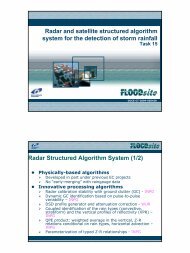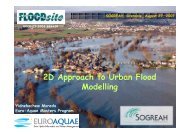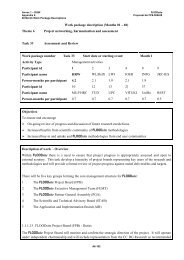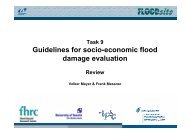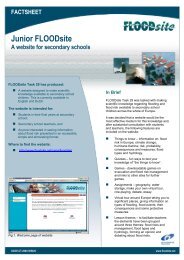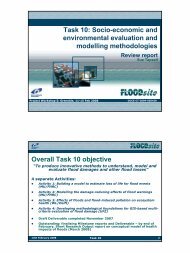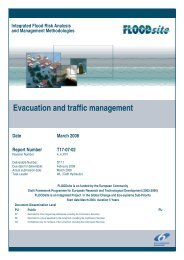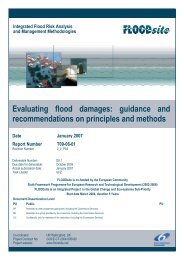Language of Risk - FLOODsite
Language of Risk - FLOODsite
Language of Risk - FLOODsite
Create successful ePaper yourself
Turn your PDF publications into a flip-book with our unique Google optimized e-Paper software.
<strong>FLOODsite</strong> <strong>Language</strong> <strong>of</strong> <strong>Risk</strong> 2 nd Ed.<br />
Contract No:GOCE-CT-2004-505420<br />
3.4.2 Analysis <strong>of</strong> revealed preferences.<br />
This approach is based on the assumption that society has arrived at a certain optimal balance between<br />
risks and benefits attributed to an activity. It is therefore assumed that it is possible to reveal factual<br />
patterns <strong>of</strong> acceptable risk levels by analysing risk behaviour and corresponding economic data. For<br />
example, national safety standards <strong>of</strong> cars, bridges, consumables and the like can be analysed in order<br />
to get information about the public acceptance <strong>of</strong> residual risk levels and the willingness to pay to<br />
invest in safety devices aiming at reducing risk. However, this model is based upon a rather<br />
rationalistic model <strong>of</strong> people, neglecting the context and power relations defining people’s decisions.<br />
It further assumes that risk acceptance is similar in different realms <strong>of</strong> life and thus risk acceptance<br />
levels <strong>of</strong> one type <strong>of</strong> risk can be derived from another risk type. However, as several studies showed,<br />
risk acceptance levels <strong>of</strong> different risk areas vary significantly and depend on the type <strong>of</strong> risk.<br />
3.4.3 Analysis <strong>of</strong> expressed preferences.<br />
This approach focuses directly on what people express as preferred standard <strong>of</strong> safety by asking them<br />
about acceptable levels <strong>of</strong> risk regarding a specific risk situation. The advantages <strong>of</strong> this direct<br />
approach seems obvious: data problems and uncertainties, which are usually part <strong>of</strong> revealed<br />
preference analyses can be prevented and risk levels are directly analysed for the risk situation in<br />
question. However, this approach can be criticised for its assumption that laypeople can handle<br />
appropriately rather complex questions <strong>of</strong> risky activities. Moreover, demanding a specific safety<br />
standard does not mean that people are also willing to pay for higher standards. And even direct<br />
questions on their willingness to pay to reduce risk are still hypothetical and do not reproduce real life<br />
situations. Choosing a proper design <strong>of</strong> investigation in order to reduce complexity and uncertainty as<br />
well as considering the context <strong>of</strong> questioning people on their preferences are therefore the most<br />
challenging tasks <strong>of</strong> this direct method.<br />
3.4.4 Cost-benefit analysis<br />
Central for this traditional economic approach is the question whether the expected benefits <strong>of</strong> a<br />
specific risk reducing activity (needed to achieve a safety level) outweigh its expected costs. Costbenefit<br />
analysis requires a holistic analysis <strong>of</strong> all benefits and costs involved in order to assess a risk<br />
reducing activity in comparison to its net benefit. A distinguishing feature <strong>of</strong> this approach is that is<br />
does not aim at identifying commonly accepted risk levels, but may result in recommendations to<br />
implement different safety standards for different risk situations, depending on the specific risk and<br />
the costs involved to reduce it. The major and <strong>of</strong>ten criticised shortcoming <strong>of</strong> this approach concerns<br />
the fact that all benefits and costs are quantified in monetary terms and aggregated to a single number<br />
without the possibility to give certain risks a larger weight.<br />
3.4.5 Multi-criteria analysis<br />
This approach is similar to cost-benefit analysis regarding the overall aim to execute a holistic analysis<br />
in order to identify and, if possible, to quantify all benefits and costs <strong>of</strong> risk-reducing activities.<br />
However, multi-criteria analysis presents the opportunity to measure the consequences <strong>of</strong> an activity in<br />
terms <strong>of</strong> different units and to leave the final weighting <strong>of</strong> criteria to the decision-makers or to a<br />
stakeholder meeting. Mathematical algorithms are then used to determine the most favourable riskreducing<br />
activity in the context <strong>of</strong> different risk perceptions, risk attitudes and preferences <strong>of</strong> decisionmakers<br />
and stakeholders. The results are then passed back and discussed within the political process<br />
in order to support the finding <strong>of</strong> the most appropriate risk-reducing activities.<br />
Since cost-benefit analysis and multi-criteria analysis are the most appropriate methods in the context<br />
<strong>of</strong> flood risk management they are used in <strong>FLOODsite</strong>.<br />
3.5 How is risk managed?<br />
The risk management model used within the <strong>FLOODsite</strong> project adopts concepts from the RIBAMOD<br />
principles for the comprehensive management <strong>of</strong> floods (originally defined at the river basin scale but<br />
also applicable to estuaries and coasts). The mitigation <strong>of</strong> flood damage and loss does not only depend<br />
upon the actions during floods but is a combination <strong>of</strong> pre-flood preparedness, operational flood<br />
management and post-flood reconstruction and review. In the context <strong>of</strong> river basin flooding,<br />
Kundzewicz and Samuels (1997) describe the RIBAMOD principles <strong>of</strong> comprehensive flood<br />
management to comprise:<br />
T32_04_01_ <strong>FLOODsite</strong>_<strong>Language</strong>_<strong>of</strong>_<strong>Risk</strong>_D32_2_v5_2_P1 30 April 2009<br />
8



